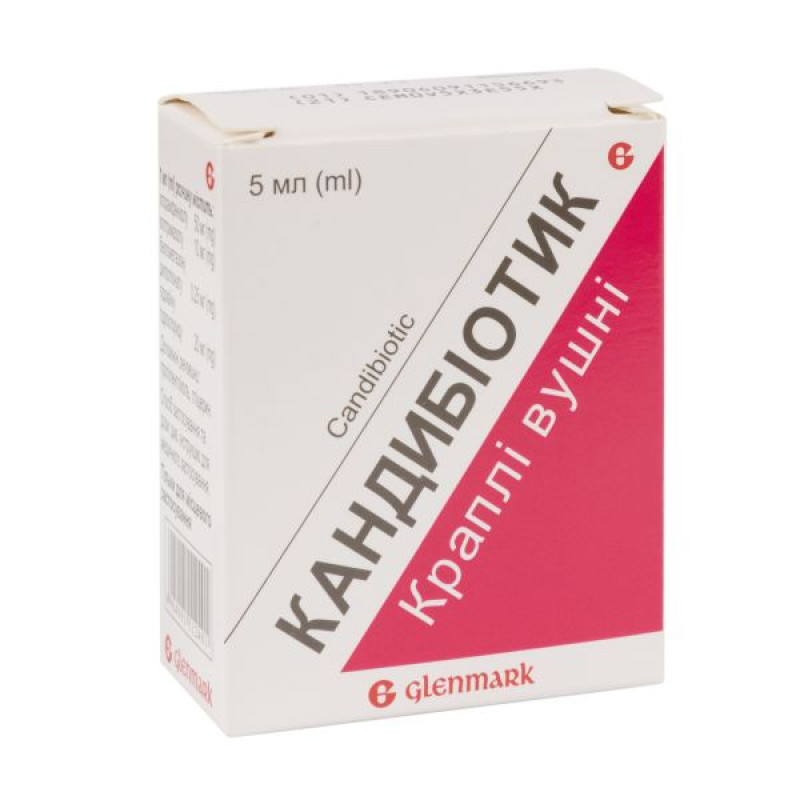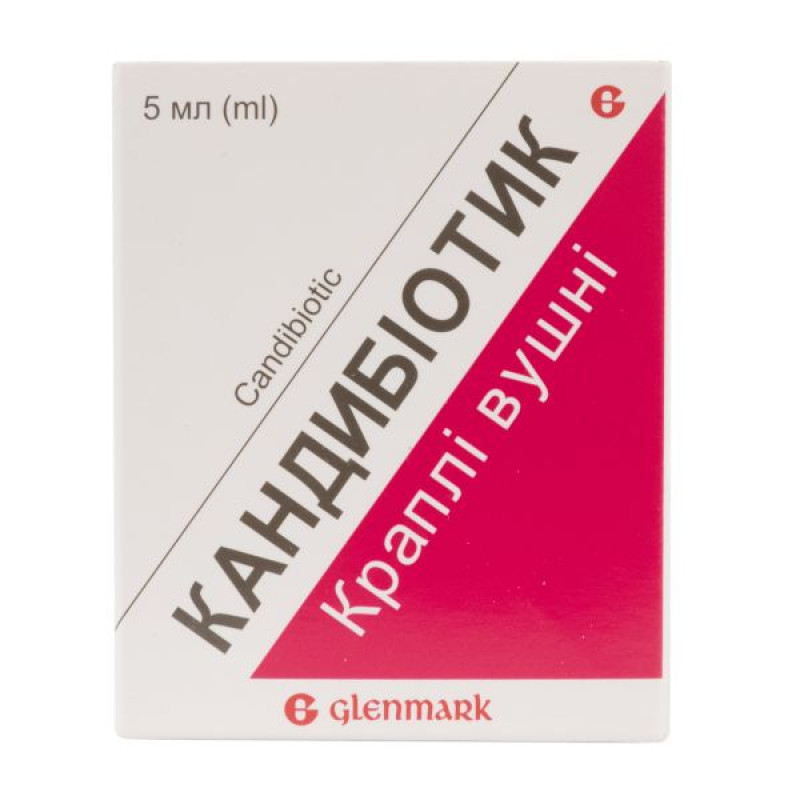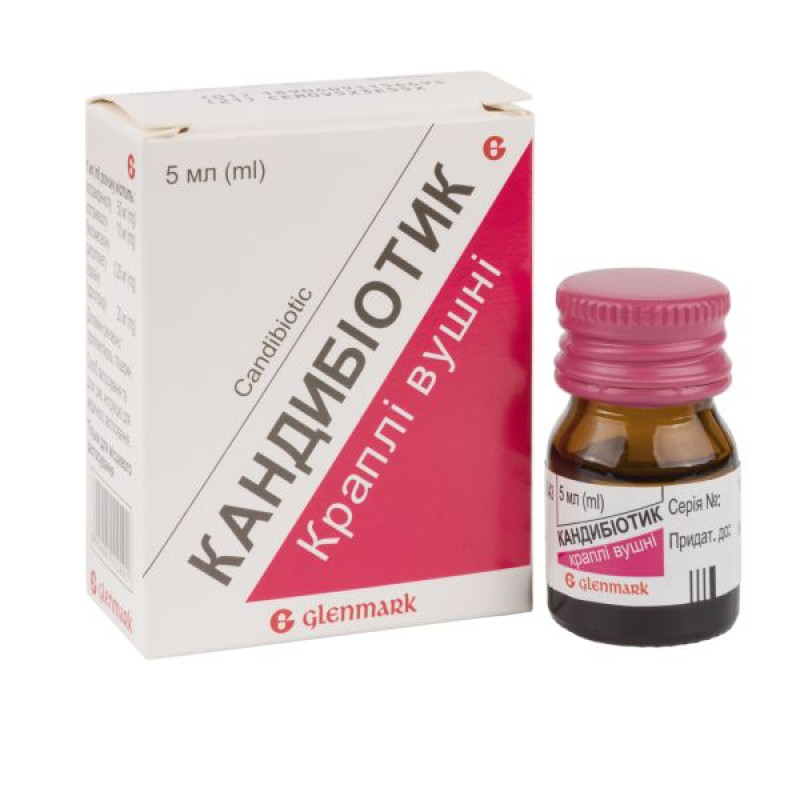Candibiotic ear drops bottle 5 ml

Instructions for Candibiotic ear drops, bottle 5 ml
Composition
active ingredients: chloramphenicol, clotrimazole, beclomethasone dipropionate, lidocaine hydrochloride;
1 ml of solution contains chloramphenicol 50 mg, clotrimazole 10 mg, beclomethasone dipropionate 0.25 mg, lidocaine hydrochloride 20 mg;
excipients: glycerin, propylene glycol.
Dosage form
Ear drops.
Main physicochemical properties: clear, light yellow liquid.
Pharmacotherapeutic group
Drugs used in otology. Combined drugs containing corticosteroids and antimicrobials.
ATX code S02C A.
Pharmacological properties
Pharmacodynamics
Combined drug for external use with antimicrobial, anti-inflammatory and local anesthetic properties. Pharmacological action of Candibiotic is due to the properties of chloramphenicol, clotrimazole, beclomethasone dipropionate and lidocaine, which are part of its composition. Chloramphenicol is a derivative of amphenicol. It has a wide spectrum of antimicrobial action. The effect of chloramphenicol on microorganisms is associated with the ability to affect protein synthesis in bacterial cells. As a rule, it acts bacteriostatically against a wide range of gram-positive and gram-negative bacteria. Chloramphenicol also effectively affects anaerobic flora.
Clotrimazole is chemically an imidazole derivative. Dermatophytes, yeasts (genus Candida, Torulopsis glabarata, Rhodotorula), mold fungi, as well as pathogens of Pityriasis versicolor (multicolored lichen) and erythrasma are sensitive to clotrimazole. In addition, clotrimazole has an antimicrobial effect on gram-positive (staphylococci, streptococci) and gram-negative bacteria (Bacteroides, Gardnerella vaginalis), as well as on Trichomonas vaginalis, Malasseria furfur, Corinebacterium minussimum. The effect of clotrimazole is associated with a violation of the synthesis of ergosterol, which is part of the cell membrane of fungi, as a result of which the structure and properties of the membranes change, cell lysis is observed.
Beclomethasone dipropionate – a synthetic analogue of adrenal cortex hormones – has anti-inflammatory, anti-allergic, anti-exudative and antipruritic effects.
Lidocaine is a local anesthetic that reduces the perception and conduction of impulses along sensitive nerve fibers at the site of action. The effect is reversible.
Pharmacokinetics
No specific pharmacokinetic studies have been conducted.
Indication
Allergic and inflammatory diseases of the external and middle ear; otorrhea; infectious diseases of the external and middle ear caused by microorganisms sensitive to the drug. Surgical interventions on the mastoid process.
Contraindication
Hypersensitivity to the components of the drug and to other amide local anesthetics.
Chickenpox, herpes simplex or shingles, ruptured eardrum.
Interaction with other medicinal products and other types of interactions
Not described. Given the low percutaneous absorption of the individual active ingredients of the drug, drug interactions with concomitant systemic drugs are considered unlikely.
Application features
The drug is intended only for topical use in the ear cavity.
The use of the medicinal product should be discontinued if signs of hypersensitivity to any of the components of the drug occur.
Candibiotic should not be used for long-term treatment.
To ensure asepticity and prevent bacterial contamination, do not touch the pipette cap to any surfaces (including the surface of the ear).
In case of accidental ingestion of the drug Kadibiotic, you should consult a doctor.
Ear preparations with chloramphenicol are not recommended for use in patients with a perforated eardrum due to the high risk of ototoxicity.
Candibiotic, ear drops, should be used with caution in patients with a history of allergic reactions to other topical or oral corticosteroid drugs due to an increased risk of developing hypersensitivity.
In children, topical corticosteroids may be absorbed in proportionally larger amounts, leading to a greater likelihood of systemic toxicity.
Following systemic absorption of topical corticosteroids, reversible suppression of the hypothalamic-pituitary-adrenal (HPA) axis occurs. Clinical signs include Cushing's syndrome, hyperglycemia, and glycosuria. These adverse reactions may be more frequent with the use of more potent steroids, with long-term treatment with the drug, with the concomitant use of occlusive dressings, and in the presence of hepatic insufficiency. After discontinuation of the drug, HPA axis function is restored rapidly and completely. In isolated cases, steroid withdrawal symptoms may occur, which may require the use of additional systemic corticosteroids.
This drug should be used with caution in patients receiving concomitant systemic antifungal therapy; in patients with diabetes mellitus; in patients with a history of immunosuppression; and in patients with weakened immune systems.
The development of blood dyscrasias, including aplastic anemia, may be associated with the use of chloramphenicol. Adequate blood tests should be performed on the patient during prolonged or intermittent therapy.
Prolonged or frequent intermittent use of topical chloramphenicol preparations should be avoided due to the possibility of hypersensitivity reactions, including bone marrow hypoplasia.
Chloramphenicol is considered unsafe for use in patients with acute porphyria.
In some cases, bacterial resistance to clotrimazole has been observed.
Prevent the drug from getting into the eyes.
Ability to influence reaction speed when driving vehicles or other mechanisms
Does not affect.
Use during pregnancy or breastfeeding
Despite the fact that clinical and experimental studies have not established a negative effect on the health of the mother or fetus, the drug should not be used during pregnancy and breastfeeding.
Method of administration and doses
For topical use.
Adults and children over 12 years of age – instill 3-4 drops of the drug into the ear canal 3-4 times a day.
The course of treatment, which is set individually, depending on the severity and course of the disease, is on average 5–7 days.
Children aged 2 to 12 years - 2 drops 4 times a day. The course of treatment is 5 days.
To use the drug, tilt your head, put the required number of drops into your ear, and keep your head tilted for a while to ensure the drug penetrates the ear canal.
Children
The medicine is used in children aged 2 years and older.
Overdose
Not described.
Adverse reactions
Allergic reactions are possible, including itching, burning and tingling at the site of injection; erythema, urticaria, edema, contact dermatitis.
Expiration date
2 years.
Storage conditions
Store in a dry, dark place out of the reach of children at a temperature not exceeding 25°C.
Packaging
5 ml in a bottle with a pipette cap, placed in a plastic bag, in a cardboard box.
Vacation category
According to the recipe.
Producer
Glenmark Pharmaceuticals Ltd.
Location of the manufacturer and its business address
Precinct No. E-37/39, M.I.D.C., Satpur, Nasik – 422 007, India.
There are no reviews for this product.
There are no reviews for this product, be the first to leave your review.
No questions about this product, be the first and ask your question.





